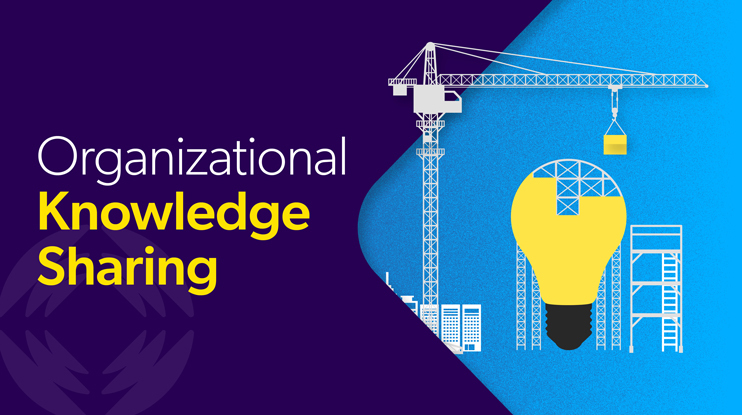Organizational knowledge sharing is far more complex than it appears on the surface. Getting it right can mean the difference between exceptional service and intra-organizational bottlenecks. Follow these four steps to make knowledge sharing a centerpiece of your enterprise’s knowledge management strategy.
If you’re wondering why your employee productivity is stagnant, it might be time to assess your culture of organizational knowledge sharing.
What is Organizational Knowledge Sharing?
Organizational knowledge sharing refers to the different ways that organizations disseminate institutional knowledge, aka collective knowledge, that accrues across employees, teams, and business units. Institutional knowledge can include: skills; processes; norms and values; relationships; experiences; and information.
The practice of organizational knowledge sharing relies on cultural, technological, and behavioral underpinnings. How well your teams share knowledge depends on openness to collaboration, available knowledge-sharing tools, motivating behavioral factors (incentivization, for example). Alongside storage and application, organizational knowledge sharing is one of the three core purposes of knowledge management (KM). The two go hand in hand.
Understanding the different types of knowledge is beneficial to planning ways to capture, organize, and plan for it to be shared:
3 Types of Knowledge
- Tacit: Knowledge that’s difficult to formalize and communicate. It is often gained through experience and is based on personal insights, intuition, and judgment. For example, a senior sales representative might know through years of experience how to massage a demo to increase its resonance with a particular type of buying group.
- Implicit: Knowledge that’s not documented, but generally understood among team members (so-called implicit knowledge, such as best practices and unwritten rules). For example, an experienced support agent may implicitly understand the best way to troubleshoot a software issue based on the environment.
- Explicit: Knowledge that’s codified in documents, manuals, and databases. Explicit knowledge can be easily shared with others and can be used to train new employees. For example, an HR rep may refer to a formally recorded process for offboarding an employee.
So why is it that so many organizations struggle with knowledge sharing — even as more than 66% of employees agree that KM improves productivity?
Our task here is to examine the role of collaboration and knowledge sharing in successful enterprises. That includes the tangible steps that enterprise leaders can take to build an infrastructure that supports a true knowledge-sharing organization.
State of Organizational Knowledge Sharing
There’s great power in teamwork. What’s knowledge sharing if not a critical aspect of teamwork? When you encourage knowledge sharing, you stand to improve organizational transparency, create a people- and collaboration-first culture, and build better connections between people and the storage of knowledge. Your organization better retains its institutional knowledge as a result.
Today, many organizations still have work to do when it comes to realizing the full potential of knowledge sharing. Just take a look the top five opportunities for KM to capitalize on right now, from the APQC 2023 Knowledge Management Priorities And Predictions survey:
- 39% say employees frustrated with chaotic, disorganized information
- 35% say employee retirements and churn making it critical to capture/transfer knowledge
- 34% say KM’s essential role as organizations embrace more remote/hybrid work
- 32% say leaders recognizing the risk of knowledge gaps and siloes
- 30% say KM’s essential role in employee reskilling/upskilling
Underlying knowledge infrastructure is the organizational culture of sharing knowledge itself. Often, culture is a huge obstacle to building a healthy practice of organizational knowledge sharing. So, how do you cultivate a willingness to share?
Common Obstacles to Organizational Knowledge Sharing
Despite seeing the upside of knowledge sharing, many employees still don’t participate, at least not at the rate most executives would expect. Why?
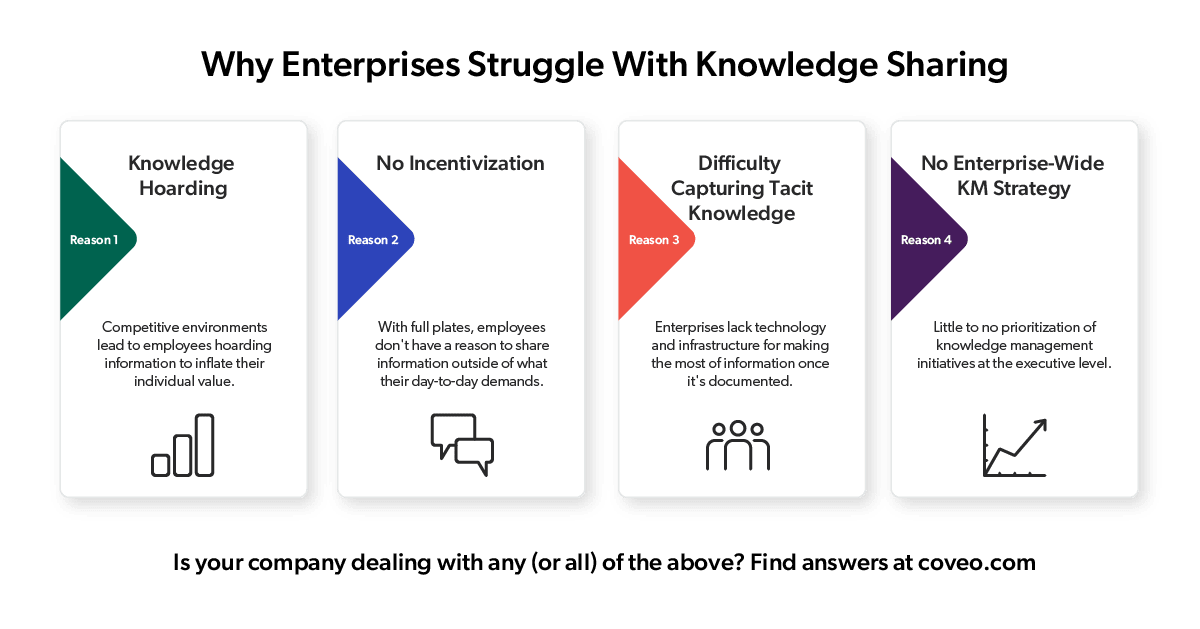
Knowledge Hoarding
Employees might perceive that knowledge transfer will degrade their individual value to the organization. Even an experienced employee might engage in knowledge hoarding based on this perception that the more relevant knowledge they acquire and keep, the more irreplaceable they become.
In competitive team settings, such as enterprise sales, some reps might successfully climb the leaderboard by keeping their most valuable knowledge—the best plays, scripts, and workarounds—to themselves. Then of course there’s the lone-wolf scenario so common to software development, in which talented devs carve out a space for themselves by doing it all on their own.
Relevant Reading: 9 Signs Your Organization Has a Knowledge Hoarding Problem
No Incentivization
Another reason for poor organizational knowledge sharing is the lack of meaningful incentives. Take professional services, as an example: so much of what professional services teams do is evaluated by billable hours. As Matt Schlessman of Kantata points out in an on-demand webinar from TSIA, documenting what worked and what didn’t for a particular project isn’t billable time. It’s not exactly what professional services teams like to do with their spare time, either.
Some organizations create explicit incentives for knowledge sharing. During my time as a technical writer for a knowledge base team, our colleagues in customer support were recognized and rewarded for monthly contributions to the knowledge base (article submissions, article revisions, SME review, etc.).
This is tricky, because offering cash for contributions can quickly pollute a knowledge base with bad content. It can also create a situation in which people just attach the full product manual to every single case without any context.
Patrick Martin, Coveo’s General Manager of Service, has his organization bake a KM index (a composite of different knowledge sharing activities) right into its MBOs, rather than incentivizing singular activities alone. Martin’s organization also conducts behavioral interviews with questions about collaboration. The idea is to capture the applicant’s mindset around knowledge sharing, among other collaborative activities.
This exercise is accompanied by a collaborative technical challenge: candidates are asked to build a search page using documentation and access to a Slack channel where they can ask questions. How do they interact with the team? What questions do they ask? All of these answers factor into Martin’s evaluations of a candidate. Finally, the candidate will complete a psychometric test against a defined profile for what Martin’s team is looking for, one tailored toward more collaborative people.
Difficulty Capturing Tacit Knowledge
Then of course, there’s the tacit knowledge that lives in each employee’s head. For instance, a seasoned sales rep might have tacit knowledge that a buyer in the banking industry wants to see a certain kind of ROI statement. The challenge is not only bringing that knowledge out of each subject matter expert, but capturing and making it into explicit knowledge in a way that a less seasoned rep can use it in context.
Often, enterprises don’t have the technology and infrastructure for an effective knowledge sharing system in place to capture this depth of nuance. In many cases, an internal wiki or internal knowledge base just isn’t enough.
No Enterprise-Wide KM Strategy
Then there’s the plain fact that many executives aren’t strategizing around KM. Even for enterprises with examples of strong knowledge sharing within certain departments, or among specific employees, many are behind in terms of KM maturity at the organizational level.
According to the Enterprise Knowledge Management Maturity Model, only 7-8% of companies are at the so-called strategic phase, which is the most mature phase. This means that most executives still don’t prioritize updates about knowledge management initiatives, nor funding in their support.
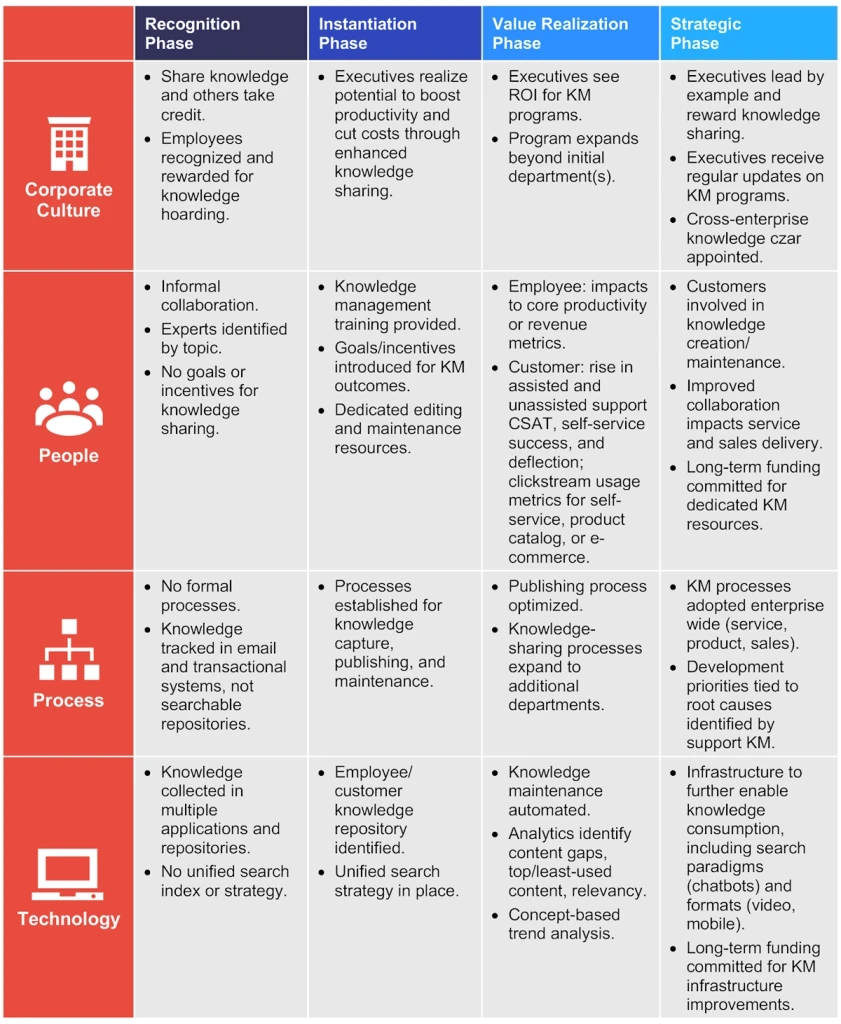
At the very least, aim for the Value Realization phase, in which:
- Employees see ROI for KM programs
- KM program expands to other departments
- KM program impacts productivity and/or revenue metrics
- KM program impacts customer metrics and/or KPIs
- Processes for publishing and sharing knowledge are optimized and cross-departmental
- Knowledge maintenance is automated, as are knowledge analytics
How to Build Infrastructure that Supports Effective Knowledge Sharing
As to the concrete steps you can take to enhance your own knowledge sharing process, I’ve gathered a few building blocks that support the growth of a strong knowledge sharing strategy.
Ask the Right Questions
Wherever your organization falls on the knowledge management maturity model, it helps to ask the right questions. 3 Simple Questions to Grow a Knowledge Sharing Culture outlines questions that help enterprises find their baselines, both in terms of knowledge sharing and company-wide knowledge management strategy:
1. Who should be involved in the knowledge transformation process?
By answering this question, you’ll know exactly who has skin in the game, from executive sponsors down to each department-specific subject matter expert. You’ll also reveal gaps in your process, both in terms of people and business units.
2. How do you encourage effective knowledge management participation?
Think back to my earlier mention of incentives as a barrier to fostering knowledge sharing practices. To find the good stuff – those incentives that actually lead to value creation – start with how you’re incentivizing participation now. Perhaps there are opportunities to tie knowledge sharing activity to incentive compensation or employee performance evals, something 51% of companies don’t currently do (source: TSIA).
3. What comes first: content or search?
This is an interesting one, because not all organizations are at a stage where they’re generating much valuable knowledge content at all. You can’t share knowledge if you don’t have any to begin with! For enterprises with existing bodies of knowledge, the way forward looks a little different (more on that in a bit). Start by asking yourself what habits you want to encourage and improve first, the creation of the knowledge itself, or how employees find it in the flow of their day-to-day work.
Structure and Standardize Company-Wide KM
John Ragsdale, Distinguished Researcher and VP of Technology Ecosystems at TSIA, touts the potential of a company-wide KM model. He’s not alone. That model is reflected in the updated TSIA KM maturity model’s focus on the strategic phase.
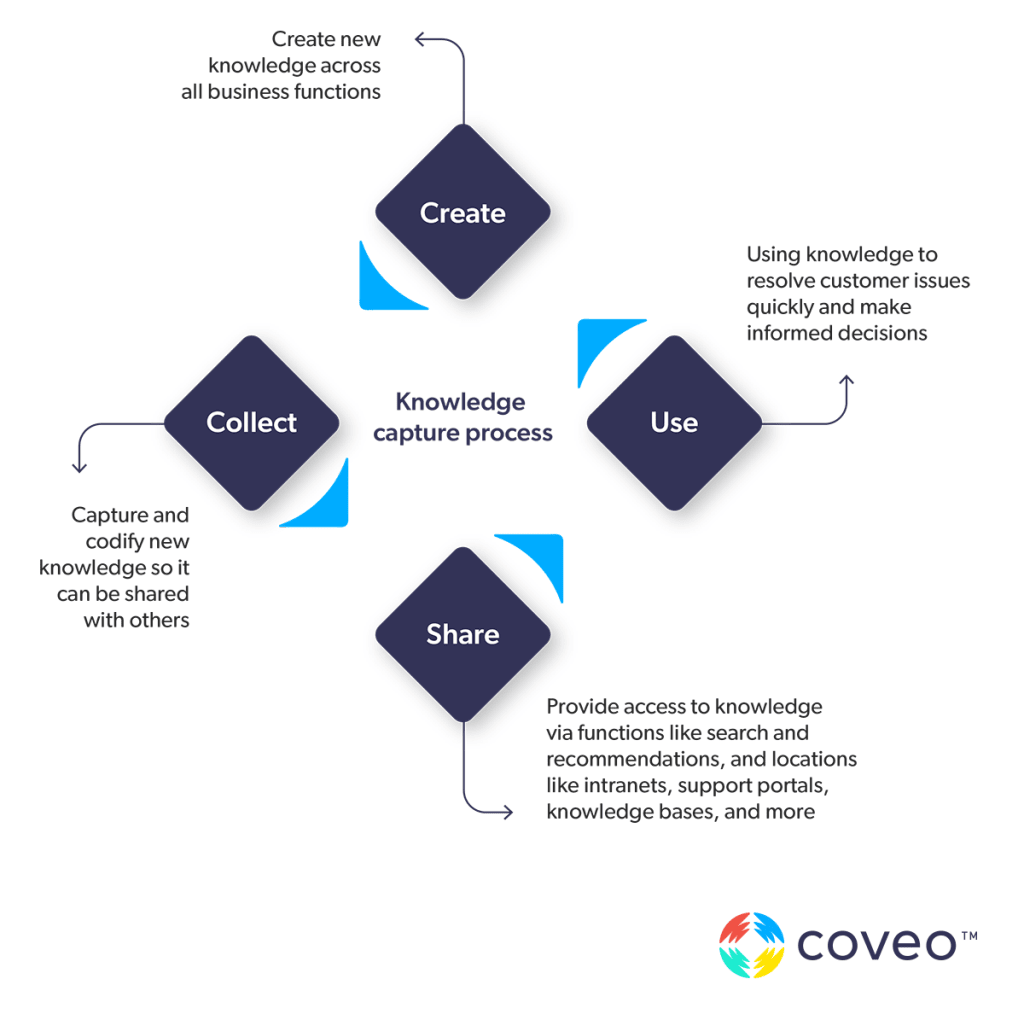
This enterprise-wide model recommends taking the KM best practices from a handful of departments – support and customer success, for example – and evangelizing those across the company. According to Ragsdale, this model requires some form of “knowledge czar” whose job it is to find these best practices and technologies for KM.
Under this model, governance would likely come from the CIO’s department, in which the best practices for knowledge exchange trickle down into the rest of the organization. Ideally, every group has its own knowledge management function and knowledge worker(s) that ensure governance is applied, given their particular needs, tools, and personnel.
In other words, a standardized knowledge management system and methodology that people are responsible for enforcing.
Sidestep the “Where Best to Store Knowledge” Debate
As to where to best store all of the collective knowledge that an enterprise generates, the question itself is in many ways moot. First of all, it varies. Even for the enterprises that do their damndest to unify knowledge flow, you might still find a conglomeration of Google and SharePoint docs, decks, and PDFs – not to mention all that goes on in Teams and Slack (all of it living in a lot of different places).
The more mature organizations will sidestep the question of where to store their knowledge altogether. Here’s what I mean:
Embed knowledge capture in the workflow
In sales, for example, you can automatically record sales interactions and store those recordings in a place that’s indexable, retrievable, well integrated. The same thing goes for creating cases from successfully resolved cases by support agents.
The idea is to make this knowledge capture part of each employee’s daily flow, without asking too much of each employee to participate. This is one of the central tenets of Knowledge-Centered Service (KCS)* and a core capability of strong knowledge sharing platforms.
Add intelligent search on top of everything
When an employee has a one-stop search experience to quickly retrieve (and share) the knowledge they need, they don’t really care where the content itself resides. An intelligent search platform can blend content from a lot of different sources into a single experience.
What’s more, the more people interact with the content, the better machine learning engines learn to serve up the most relevant content the next time something similar comes up.
That said, a proliferation of repositories can increase cost of ownership, so limiting content repositories and maintaining clear governance has its benefits. This might entail assigning knowledge owners across teams who can author, organize, and maintain their own repositories (again tying back to the concept of company-wide KM described above).
Layer in Analytics
It’s one thing to bring knowledge transfer out of knowledge silos and into a searchable experience of some kind. It’s another to link everything together and enrich the experience with contextual data — to present best-bet content based on deep, contextually based analysis of many other interactions.
Back to Matt Schlessman of Kantata, who notes the great value of a mechanism for not only capturing expertise and practices from different professional services projects, but also using project data and other analytics to tie everything together and deeply enrich any insights and recommendations that result thereafter.
It’s what Coveo calls an intelligent search and recommendation platform, coincidentally. Here’s a snapshot of that platform in action:
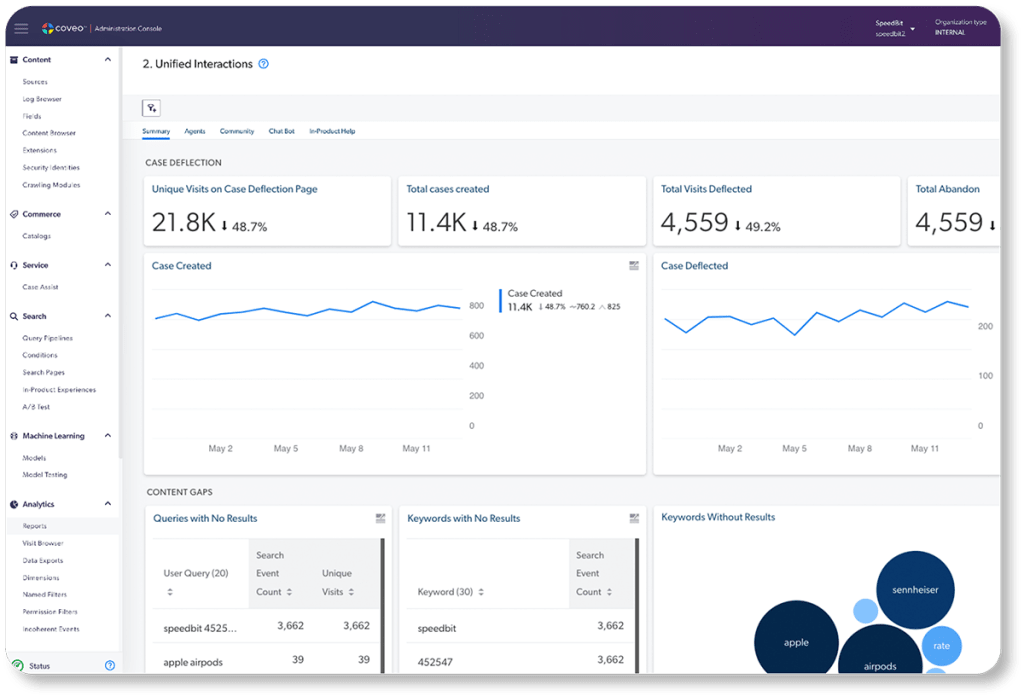
The Role of AI in Organizational Knowledge Sharing
Knowledge sharing is evolving, thanks in large part to generative AI. Generative answering opens the door to an always-on resource that employees can lean on for knowledge retrieval, ideation, and even creation.
Imagine if every employee—regardless of timezone or location—had an AI-powered copilot that they could rely on for up-to-date and comprehensive organizational knowledge. This is certainly possible in the current AI landscape.
Of course, generative AI comes in many forms, many of them with considerable shortcomings (at least as far as knowledge sharing goes). To deploy generative AI in support of knowledge sharing, you’ll need a few building blocks in place:
- Measures for compliance, accuracy, and security
- An organized and unified content index
- Viable employee use cases for day-to-day use
Coveo brings these building blocks together into a single experience, replete with built-in safeguards. Through the combination of an AI relevance layer, secured index, and large language model (LLM), Coveo Generative AI supports a number of use cases for knowledge sharing, from a reliable company-wide search experience to embedded (and personalized) recommendations.
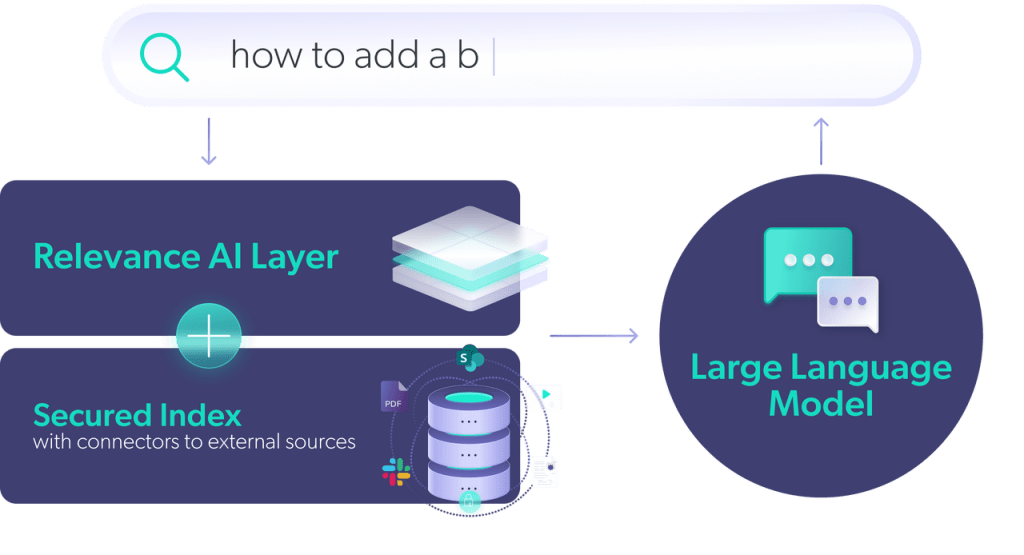
Start Small and Build from the Bottom Up
I wish I could tell you there was a magical knowledge sharing system to download, install, and automatically address every single knowledge gap. The issue requires a far more nuanced approach. But it can start with what I’d consider a universal truth: most employees generate and interact with critical knowledge on a daily basis—sometimes dozens upon dozens of times.
Start from the bottom up.
Make knowledge sharing and collaboration a habit by building those activities into every process and interaction. Launch department-specific pilot projects designed to showcase the power of knowledge sharing, then bring that data up to the execs to secure the required attention, funding, and investments needed for a broader transformation. Your pilot projects may well include generative AI applications that support knowledge sharing.
It will take time, as most transformations do; but the process will put enterprises in a better position to make the most of the technologies already out there – powerful knowledge sharing platforms that take collaboration to the next level.
Dig Deeper
Growing a knowledge-sharing culture within your organization is the first step toward better knowledge management. But don’t forget about all of the channels where you need to deploy that knowledge in!
Get knowledge sharing practices for managing multi-channel knowledge management in our ebook.
*KCS® is a service mark of the Consortium for Service Innovation™

